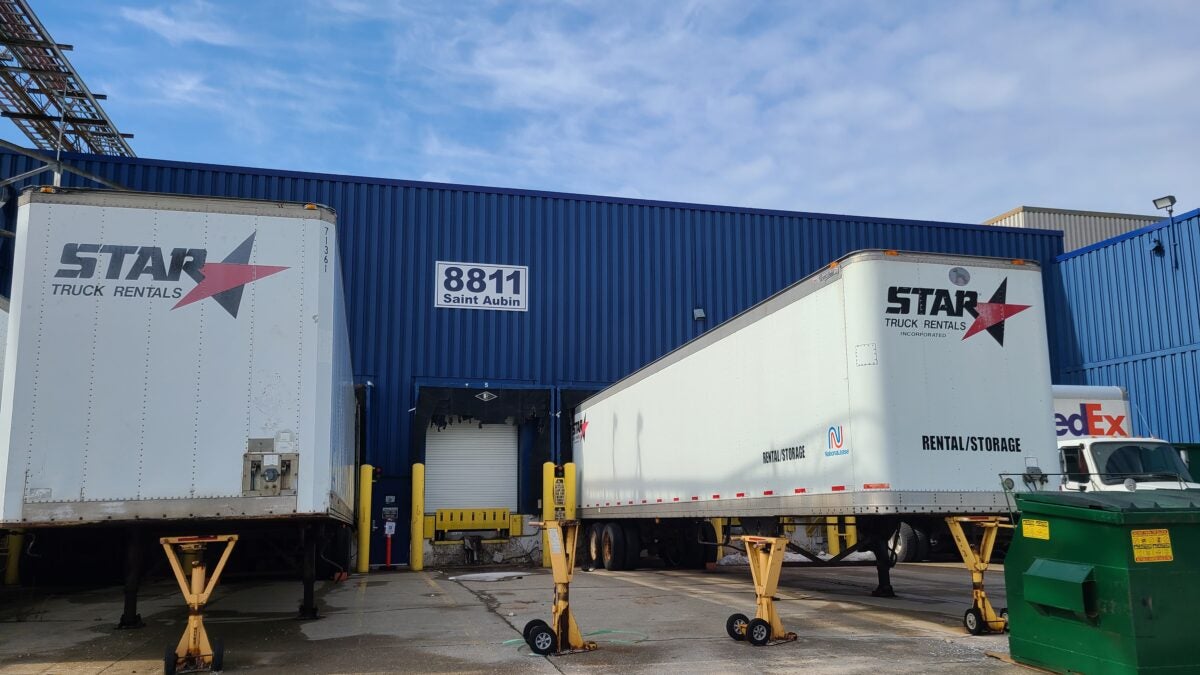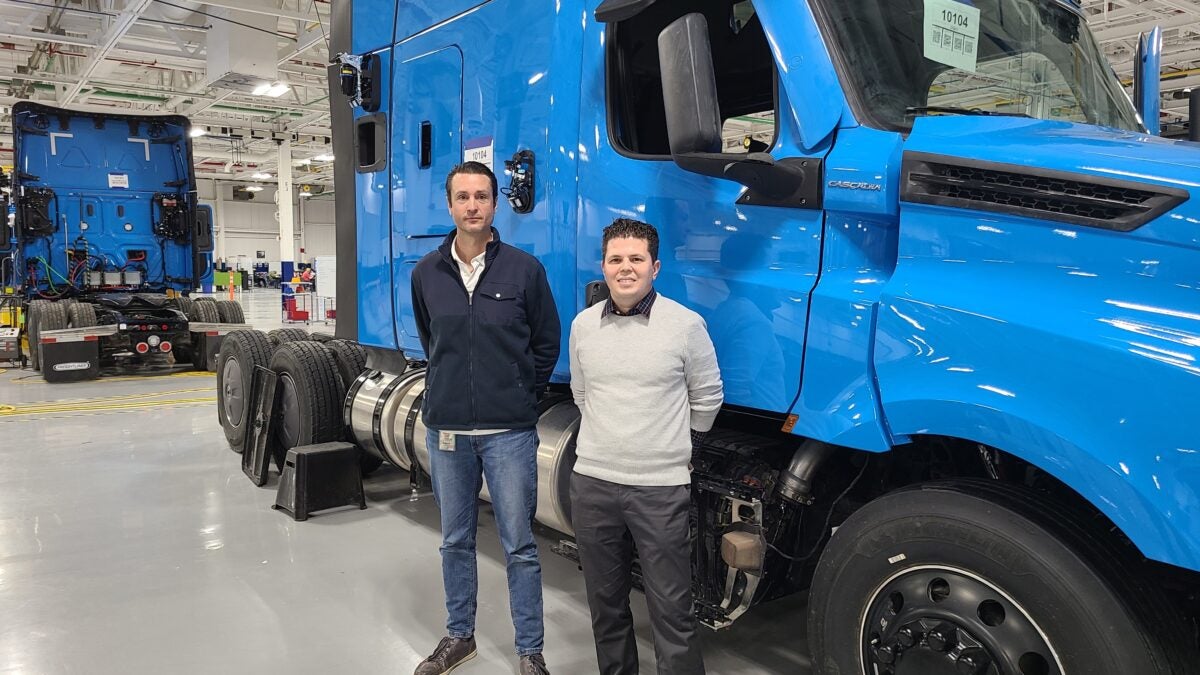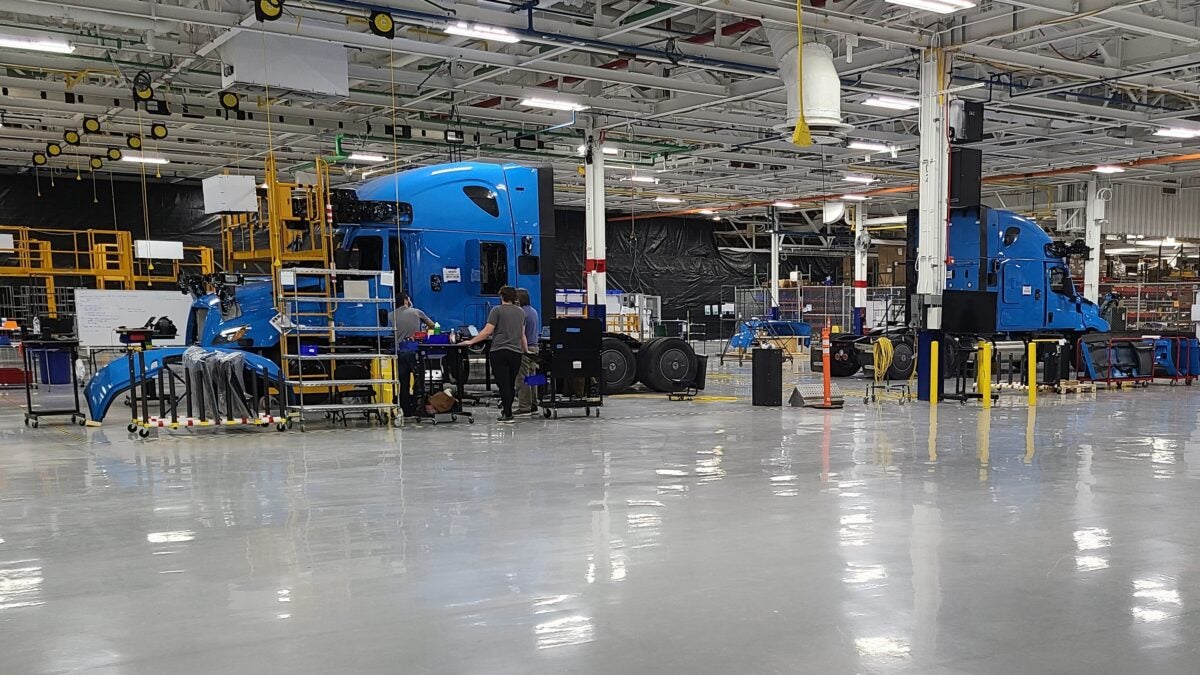Editor’s note: Clarifies that Waymo trucking autonomy efforts began in 2017.
DETROIT — Manufacturing of Waymo Via robot-driven Freightliner Cascadias, part of the future of long-haul trucking, resides in a century-old industrial building on St. Aubin Street where Chevrolet Gear & Axle operated in the mid-20th century heyday of General Motors.
But you wouldn’t know it from the sign outside. There isn’t one.
Before the subsidiary of Google parent Alphabet Inc. arrived in 2019, the complex housed American Axle & Manufacturing, a 1990s startup that took over five axle plants GM no longer wanted. AAM, which now has 80 facilities in 17 countries, closed its Detroit manufacturing facilities in 2012 and began demolishing buildings in the area in late 2013.
But the blue-painted structures on the west side of the street survived. A small parking lot surrounded by a 10-foot fence hints at the future. Two electric vehicle chargers occupy spaces closest to the steel entry door marked shipping and receiving.

A couple of blocks away is another sign of the times. Hundreds of new Ford F-150 pickup trucks cover a weed-strewn lot where other industrial buildings once stood. The trucks exemplify the ongoing semiconductor shortage. Otherwise complete, they cannot be shipped to dealers until missing microchips are sourced.
Just across the Detroit border in Hamtramck, a cultural melting pot surrounded by the Motor City, a $2.2 billion makeover of the former Cadillac manufacturing complex is now GM’s Factory Zero electric vehicle factory.
But it is the area’s history that creates a family connection for Patrick Cadariu, Waymo’s head of fleet operations. His great-grandfather, Francis Thompson, worked here when it was Chevrolet Gear & Axle.
“I found out after we had signed the deal and moved in,” he said. “My mom actually sent me his obit from the paper that had reference to it.”
‘Not here to make a show’
Waymo leases 80,000 square feet of the building with an option for 200,000 more. But it operates in anonymity. No exterior signage, just a large street address is visible between 53-foot dry van storage trailers parked at streetside loading docks.
“We’re not here to make a show,” Cadariu said. “We’re focused on doing the work and installing the Waymo Driver and getting these cars and trucks on the road. “
Pragmatism drove the decision to locate assembly in Detroit. Waymo has had an engineering center about 30 minutes away in suburban Novi, Michigan, since 2015.
Just past the guard cage in the darkened entryway, bright light from high ceiling lamps bounces off a practically spotless floor devoid of typical signs of volume manufacturing. Four Cascadias equally spaced stand in various build stages. Eventually, they will operate without human drivers.
On the eastern wall, an ample storage area holds an inventory of parts and components. To the north, a tightly stretched black, canvaslike curtain separates today’s workspace from what may or may not be a future expansion.
“Being flexible and having options is what’s really important,” Cadariu said. “We have it available for when we need it, so we’re not going to be scrambling to find space.”

Waymo engineers and assemblers from Canadian mobility technology company Magna International review parts and discuss troubleshooting from tables near the trucks. The room is mostly quiet. No din of machinery. Just the occasional clang of a dropped hand tool.
“We’re not interested in spending a lot of financial capital on facilities and assembly lines and things of that nature when it’s not required and not needed,” Cadariu said. “It’s very much a partnership model where we focus on what we’re best at and then we find world-class partners to do what they’re best at.”
For example, Magna, which is also the contract manufacturer for the electric Ocean SUV from startup Fisker Inc., won the assembly work based on Waymo’s estimation that it was “clearly ahead of the curve” among non-OEM vehicle builders.
TuSimple, the only autonomous trucking developer with more trucks on record than Waymo, does its own modifications of Navistar LT trucks at its facility in Tucson, Arizona, as it advances its driverless truck commercialization plan for 2024.
Not in a rush
Unlike competitors predicting driver-out operations in the 2024 time frame, Waymo declines to give a specific year when its trucks will be ready for prime time. It has testing partnerships with J.B. Hunt Transportation Services and third-party logistics giant C.H. Robinson. It also moved freight in trial runs for UPS in Texas last November and December.
Waymo’s autonomous experience dates to the Google Self-Driving Car Project from 2009 that became Waymo in 2016. Self-driving tucking efforts began in 2017. The Waymo Via trucking unit debuted in 2019.
Every vehicle with the Waymo Driver software and hardware package is manufactured in Detroit before being sent to Ohio, Arizona, Texas or California for testing. A month ago, the Cascadias shared space with Jaguar I-Pace battery-electric crossover sedans being equipped with the Waymo Driver.
Driverless Chrysler Pacifica minivans with the fourth-generation Waymo Driver have ferried riders in eastern Phoenix suburbs since late 2020. The I-Pace, which has the fifth-generation system, will replace those just as the Cascadias will replace a fleet of Peterbilt Model 579s with the last-generation system.
“One of the beauties of the Waymo Driver is we’re designing it to be kind of portable and to have little customization required to go from platform to platform,” Cadariu said.
Central nervous system
The Waymo Driver system is fully integrated into the Cascadia rather than retrofitted. Transferring it from the I-Pace to the Cascadia requires changes to senr placement because of the gargantuan size of the truck compared to the crossover.
“This is the first deployment of a truly redundant system.”
jason Digrande, waymo oem program engineering lead
“This is the first deployment of a truly redundant system,” said Jason DiGrande, OEM program engineering lead.
Waymo gave Freightliner parent Daimler Truck North America a list of 1,500 requirements it needed to safely integrate the Waymo Driver’s compute system, which covers the back wall of what would otherwise be the sleeper cab.
Perception, or what the Waymo Driver sees; component redundancy to account for the lack of a human driver; and dealing with sensor-mucking weather events drove many of the requirements.
Under the front of the chassis, a redundant steering system helps assure the truck can safely get to the side of the road if one system fails. Ditto for redundant braking systems beneath the fifth wheel. A redundant battery power system is bolted to the back of the cab. All of these add only insignificant weight considering the 18,700 pounds the tractor weighs.

Think about it as a Cascadia with an electrical architecture that they’re developing and Waymo Driver requirements incorporated into it,” DiGrande said. “The foundation and the backbone is a Cascadia. There is a structure that has been placed there per our requirements that we will bolt onto, but it’s not like we’re drilling holes or anything like that.”
On the exterior, duplicate lidars, radar and cameras fan left to right across a bar above the windshield. Radars and lidars also are in the hood. The fifth-generation system includes cleaning systems on all sensors and cameras, including thermal cameras for night vision.
In their exposed state, the technologies appear outsized and awkward.
“It looks quite elegant once we have the covers on it,” Cadariu said. “We have a very thoughtful integration that makes it look seamless and all well tied together.”
The 2020 agreement between Daimler and Waymo followed the truck manufacturer’s 2019 purchase of a majority of Torc Robotics, which is building a ground-up autonomous Cascadia as an independent subsidiary.
Battery-electric autonomy?
Could the Waymo Driver be integrated into the battery-electric eCascadia, whose zero-emissions profile increasingly matters in California and other states that have adopted its Advanced Clean Truck rule for 2024?
“The way we designed it, this could be scaled onto an eCascadia,” DiGrande said. “We haven’t designed anything that would prevent us from being able to do that.”
Kent Yiu, the head of manufacturing and a former GM manufacturing engineer who worked in China for both GM and Apple, said Waymo manufacturing has come a long way.
“Seven years ago when we were just a startup, there was no structure in place in terms of working with the engineering side and contract manufacturers,” he said. “Now it’s a much more refined process [after] going through close to 10 builds. We have a process to communicate design and how to resolve issues.”
Related articles:
Waymo Via partners with C.H. Robinson to explore small fleet autonomy
Seasonal assist: Waymo Via testing autonomous trucks in Texas with UPS
How much do Waymo Via’s autonomous trucks benefit from driverless cars?








Shawn
How about we automate all the ports before we replace millions of drivers first? Just a thought.